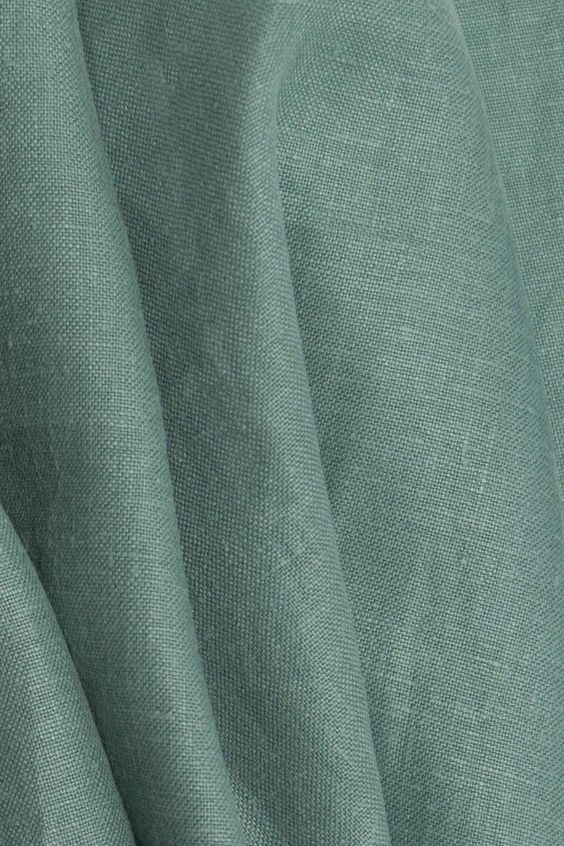Linen, a fabric synonymous with coolness and classic elegance, has graced wardrobes and homes for millennia. But what exactly is linen made of? This natural textile is crafted from the fibers of the flax plant, specifically the stem. Often compared to cotton, linen distinguishes itself through its unique origin, deriving its threads not from the fluffy bolls of the cotton plant, but from the sturdy stalks of flax. This fundamental difference in composition contributes to linen’s distinctive properties and enduring appeal.
Garments fashioned from linen are highly prized, particularly in warm and humid climates. Unlike cotton, which can retain moisture, linen excels in quick drying, a characteristic that significantly enhances comfort in hot weather by minimizing heat retention. This breathability and moisture-wicking capability make linen a go-to choice for staying cool and comfortable.
However, the journey from flax plant to finished linen fabric is notably more intricate and resource-intensive than cotton production. This complexity has contributed to a gradual decline in linen’s widespread popularity since the advent of the cotton gin, which revolutionized cotton processing. Despite this shift, linen has not faded into obscurity. Its unique attributes continue to sustain its production globally, with countries like China maintaining significant linen output.
Before delving deeper, it’s crucial to distinguish between “linen” and “linens.” “Linen” refers to the fabric itself, woven from flax fibers and utilized in clothing and household items. “Linens,” on the other hand, is a broader term, often used to describe household textiles like bedding and towels, regardless of their fiber composition. Historically, “linens” implied items made exclusively from linen, as it was the primary material for these goods. Today, while the term persists, these items may be made from various fabrics, sometimes causing confusion.
Delving into Linen: From Flax Plant to Fabric
The Flax Plant: Nature’s Gift
The story of linen begins with the flax plant (Linum usitatissimum), a slender annual that thrives in cool, temperate climates. The flax plant is not only the source of linen fiber but also linseed oil and flax seeds, making it a versatile crop. For linen production, it’s the stem of the flax plant that holds the key. Inside these stalks are cellulose fibers, the very essence of linen fabric. These fibers are known for their strength, durability, and smooth texture, which translate directly into the qualities of linen fabric.
Harvesting and Fiber Extraction: The Journey Begins
Transforming flax stalks into usable linen fibers is a multi-step process that has evolved from ancient manual techniques to modern industrial methods. Historically, and still practiced by some artisanal producers, flax was retted using natural processes like dew retting (laying flax on fields) or water retting (submerging flax in water bodies). These methods rely on microbial action to decompose the pectin that binds the flax fibers to the woody stem. Modern industrial retting often employs chemical processes to expedite fiber separation, though environmental concerns are increasingly driving a return to more sustainable, water-based retting methods.
A Storied Past: The History of Linen
Ancient Origins
Linen boasts a history as rich and textured as the fabric itself, with evidence suggesting its use dating back to prehistoric times. Archaeological discoveries indicate that Neolithic communities in Europe were crafting textiles from linen as early as 36,000 years ago. This makes linen one of the oldest known textiles, potentially predating even this early evidence.
Further historical clues emerge from ancient dwellings on Swiss lakeshores, dating back approximately 10,000 years. While linen’s domestication is believed to have originated in ancient Mesopotamia, it was in Ancient Egypt where linen truly flourished.
Linen Through the Ages
The Egyptian climate played a crucial role in elevating linen to prominence. Its inherent white color, breathability, and quick-drying properties made it ideal for apparel in the scorching sun. Linen became the most valued textile in ancient Egypt, even serving as a form of currency. Beyond daily wear, linen held spiritual significance, used for burial shrouds and mummy wrappings.
The Ancient Greeks also adopted linen for clothing and household textiles, and the Phoenicians disseminated linen production techniques across Western Europe. Interestingly, formal regulation of flax cultivation in Europe didn’t appear until the 12th century AD.
Ireland later emerged as a European linen hub, with Belfast earning the moniker “Linenopolis” by the 18th century due to its thriving linen trade. Linen remained a staple through the colonial era. However, the rise of cheaper and more easily processed cotton gradually diminished linen’s dominance in the European textile economy.
The Making of Linen: A Step-by-Step Guide
The production of linen, while modernized, still retains core processes rooted in traditional techniques. Here’s a breakdown of the journey from flax plant to linen fabric:
1. Planting and Growth
Flax plants require approximately 100 days to mature and are sown in cooler seasons as they are sensitive to heat. Modern planting typically employs machinery for efficient sowing.
2. Harvesting
Harvesting occurs when flax stems turn yellow and seeds become brown. While manual harvesting is possible, machines are commonly used to pull up the flax plants.
3. Retting (Fiber Separation)
Retting is crucial for separating the usable flax fibers from the woody core of the stalk. This can be achieved through water retting, dew retting, or chemical retting. Water retting, considered more environmentally friendly, involves submerging flax in water to allow microbial decomposition. Chemical retting is faster but raises environmental concerns due to potential water pollution.
4. Breaking
Once retted, the flax stalks are broken to further separate the outer, less desirable fibers from the inner, usable fibers. Rollers crush the stalks, and rotating paddles remove the outer fibers.
5. Combing
The inner flax fibers are then combed to create thin, aligned strands, preparing them for spinning.
6. Spinning
Spinning transforms the combed flax fibers into yarn. Traditionally done with a flax wheel, modern linen production relies on industrial spinning machines. Spreaders connect short fibers, creating rovings, which are then spun into yarn.
7. Reeling
The spun yarn is reeled onto bobbins. To ensure yarn cohesion and prevent breakage, reeling is often performed in humid conditions, and the yarn may be treated with a hot water bath.
8. Drying
Finally, the flax yarn is dried and reeled onto bobbins, ready for dyeing, treatment, and weaving into linen fabric.
Linen’s Versatility: Uses and Applications
Historically a dominant textile, linen’s applications remain diverse, though its market share has shifted. While cotton has replaced linen in many areas, linen retains unique advantages and niche applications.
Apparel
Linen remains a popular choice for clothing, especially in warm climates. Its breathability and moisture-wicking properties make it ideal for shirts, pants, dresses, skirts, jackets, and suits. Linen is also favored for lingerie, underwear, nightgowns, and robes due to its comfort and skin-friendly nature.
Home Textiles
Linen continues to be a sought-after material for home textiles. Napkins and tablecloths made from linen are common, valued for their elegance and durability. While cotton is more prevalent for towels, linen hand towels, kitchen towels, and bath towels are still available, prized for their absorbency and quick-drying qualities. Linen bedding, including pillowcases and sheets, offers durability and a luxurious feel, often achieving higher thread counts than cotton without compromising strength.
Other Uses
Beyond apparel and home goods, linen finds applications in industrial contexts. Historically, linen canvas has been the preferred surface for oil painting. Linen is also used in items like luggage, thread, aprons, bags, and even historically in diapers.
Global Linen Production and Cost
Major Producers
China currently leads global linen production, mirroring trends in most textile manufacturing. However, Europe maintains a strong presence in high-quality linen production. Ireland, Italy, and Belgium remain significant producers, particularly of premium linen. The United States also produces linen, mainly for homeware applications.
Cost Factors
Linen fabric is generally more expensive than cotton due to the more complex and labor-intensive production processes involved in flax cultivation and fiber extraction. While exact figures for unprocessed linen yarn are less readily available, woven linen fabric typically ranges from $5 to $12 per yard. This positions linen as one of the more costly natural fibers, yet its desirable qualities justify its continued demand in specific markets.
Types of Linen Fabric: A Closer Look
While all linen originates from flax fibers, variations in weaving techniques result in different types of linen fabric, each suited for specific purposes.
1. Damask Linen
Damask linen is characterized by its intricate patterns woven on a Jacquard loom, resembling embroidery. It is a decorative linen, less suited for everyday use and more common in formal settings for items like tablecloths and ornamental pieces.
2. Plain-woven Linen
Plain-woven linen is a durable and versatile type, frequently used for towels (dish, hand, kitchen). Its relatively loose weave provides good absorbency without sacrificing durability.
3. Loosely-woven Linen
Loosely-woven linen is the most absorbent linen type but also the least durable. Its primary application is in products requiring high absorbency, such as reusable diapers and sanitary napkins.
4. Sheeting Linen
Sheeting linen is designed for apparel and bedding. It has a close weave, a soft, untextured surface, and typically a higher thread count than other linen types, making it comfortable against the skin.
Environmental Footprint and Sustainability
Linen is often lauded as a more sustainable fabric choice compared to synthetic textiles and even cotton in some respects. However, its environmental impact is not without nuances.
Environmental Concerns
The primary environmental concern in linen production stems from the retting process. Chemical retting, while faster, utilizes chemicals like alkali or oxalic acid, which can pollute waterways if not properly managed. Water retting is a more eco-friendly alternative, relying on natural microbial action, but it is slower and can increase production costs. Organic linen certifications often mandate water retting.
Flax cultivation can also contribute to soil degradation if unsustainable farming practices are employed. Soil erosion and land conversion are potential concerns, though flax can be grown in rotation with other crops, which can mitigate some of these issues.
Sustainability and Certifications
Despite these concerns, linen generally holds a favorable position in terms of sustainability. As a natural fiber, linen is biodegradable, unlike synthetic fabrics that contribute to persistent plastic pollution. Linen also avoids the microfiber pollution associated with synthetic textiles.
Furthermore, linen production typically requires less water and fewer pesticides than cotton cultivation. Choosing linen produced with sustainable practices, such as water retting and responsible land management, minimizes its environmental footprint.
Certifications like organic certifications from the USDA and European Union ensure linen is grown and processed according to stringent environmental standards. OEKO-TEX certification focuses on the safety of linen products for consumers, verifying the absence of harmful substances.
In conclusion, linen, crafted from the resilient flax plant, is a fabric with a rich history, exceptional properties, and diverse applications. Understanding “what linen is made of” reveals not just its composition but also the intricate processes and environmental considerations that shape this enduring and valued textile.

